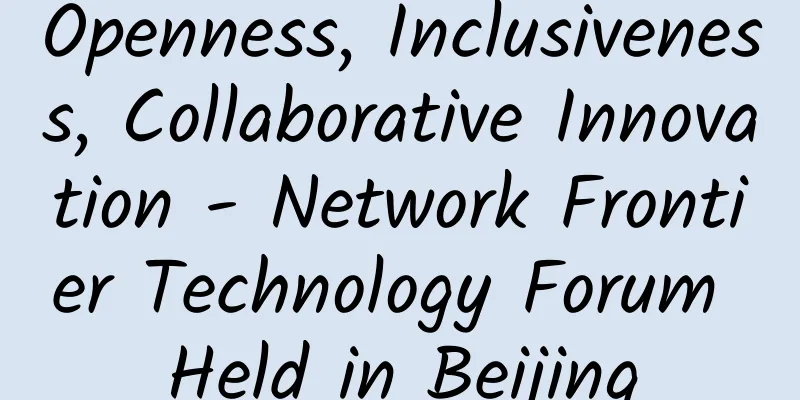Openness, Inclusiveness, Collaborative Innovation - Network Frontier Technology Forum Held in Beijing

|
On October 12, 2021, during the 2021 China IPv6 Innovation and Development Conference held in Beijing, the "Network Frontier Technology Sub-Forum" co-organized by China Academy of Information and Communications Technology and Huawei Technologies Co., Ltd. was successfully held. The sub-forum was themed "Openness, Inclusiveness, Collaborative Innovation". Leaders from relevant ministries and enterprises such as the Central Cyberspace Affairs Commission, the Ministry of Industry and Information Technology, China Telecom Research Institute, China Mobile Research Institute, China Unicom Research Institute, Huawei, Tsinghua University, and Huazhong University of Science and Technology attended the conference. More than 200 representatives from operators, enterprises, and universities from all over the country attended the forum to discuss and share around network technology innovation. The morning agenda of the sub-forum was chaired by Ao Li, Director of the Institute of Technology and Standards of the China Academy of Information and Communications Technology. Zhang Peng, Deputy Director and First-Class Inspector of the Information Development Bureau of the Cyberspace Administration of China, and Liu Yulin, Deputy Director of the Information and Communications Development Department of the Ministry of Industry and Information Technology, attended the conference and delivered opening speeches.
Zhang Peng said that the 14th Five-Year Plan period is a critical period for my country's IPv6 development to accelerate and upgrade. Efforts to build an advanced and open next-generation Internet can better support our progress from a network power to a network power. This requires us to do three things well. First, we must persist in innovation and empowerment, build a solid foundation for digital infrastructure, adhere to the innovation-driven development strategy, and carry out IPv6+ network product research and development with the overall promotion of IPv6 technology innovation and integrated applications as the main line; second, we must build an industrial ecology, continue to strengthen industrial innovation, and create a good ecology to support a network power and digital China. Third, we must deepen international cooperation and jointly promote the evolution and upgrading of the next-generation Internet. Liu Yulin pointed out that as a next-generation Internet technology innovation system based on IPv6, IPv6+ can meet the needs of business scenarios such as 5G bearer and cloud-network integration, promote the evolution and upgrading of network architecture, and accelerate network technology and application innovation. Facing the important opportunity of global Internet evolution and upgrading, we must grasp the general trend, further promote new breakthroughs in the development of IPv6 in my country, and make new and greater contributions to the construction of a strong network country and digital China. He also put forward requirements for promoting large-scale deployment, focusing on building an industrial ecosystem, and continuously improving the standard system. In the session of "IPv6+ Technology Innovation Progress - and White Paper Release", Ao Li elaborated on the connotation of IPv6+ and pointed out that IPv6+ is a technology innovation based on IPv6, a further development of IPv6, and a further improvement of IPv6 network capabilities. The development of IPv6+ is divided into three stages. The goal of the first stage is to simplify the network and realize the rapid issuance of services; the second stage is to use network slicing, flow detection, new multicast and other technologies to achieve user experience guarantee; the third stage is to achieve the deep integration of network and application through application-aware network, application-driven network programming, network flow-by-flow SLA guarantee and other means to ensure the ultimate experience of key applications. IPv6+ will enable the digital development of the entire industry, realize the intelligent connection of all things, and ultimately realize IP on Everything by improving network capabilities. Through the IP network, one end connects everything and the other end connects applications to deliver data to enterprises, families and individuals. In the keynote speech of "Promoting IPv6 Technology and Application Innovation and Building Advanced Cloud Network Infrastructure", Chen Yunqing, Vice President of China Telecom Research Institute, reviewed China Telecom's practical experience in IPv6 network and pointed out that IPv6 is the key link and starting point for realizing cloud network integration. Only by introducing technologies such as SRv6 and slicing to realize flexible scheduling of network resources can cloud network integration be truly achieved. Vice President Chen Yunqing also shared China Telecom's related practices in IPv6 single-station backbone network and metropolitan area network. He pointed out that the large-scale deployment of IPv6 has achieved phased results. The current main task is to increase traffic, optimize performance with the help of network transformation, enhance security capabilities, actively carry out IPv6+ practice, and continue to innovate technology to make IPv6+ a powerful tool for IPv6 to move forward.
Duan Xiaodong, deputy director of China Mobile Research Institute, delivered a keynote speech via video on "IPv6 technology innovation promotes the development of 5GA/6G technology". He pointed out that in the post-IPv6 era, we have greater innovation opportunities and need to increase innovation efforts to promote more original technologies to become international standards. We have taken the lead and made initial progress in IPv6 computing networks, network slicing, digital twins, etc. In addition, the combination with 5G-A/6G is an opportunity to achieve innovative development of IP technology. The development of IP technology has become one of the important driving forces. We should combine this opportunity to achieve innovative development of IP technology, implement many technologies, promote development in 5G and 6G, and also achieve IPv6 technology innovation. Tang Xiongyan, deputy director and chief scientist of China Unicom Research Institute, pointed out in his speech on the theme of "Innovation and Application Practice of Computing Network System Based on "IPv6+"" that with the development of edge computing, computing power has become ubiquitous. China Unicom is committed to building a computing network through 1+N+X, and the most critical and important thing is to build a computing network foundation through IPv6+. On this basis, four aspects of computing power are constructed, namely policy routing + network slicing + application perception + computing power perception, and services are provided for X types of commercial application scenarios. The scheduling of the entire network resources will be unified and scheduled in combination with the status of cloud, computing power and network to meet the requirements of differentiated experience, and ultimately to achieve network as a service.
Latif Ladid, Chairman of IPv6 Forum & ETSI IPE, delivered a speech via video on "IPv6 Innovation Accelerates Digital Transformation". He pointed out that in the 5G and cloud era, the introduction of SRv6 technology and the deployment of IPv6+ are faster and can provide end-to-end services. ETSI is working with EU regulators to promote IPv6 deployment. In the next five years, all parties in the industry need to continue to work hard to achieve the goal of IPv6 Only. Cisco Fellow Clarence Filsfils participated in the conference via video. He proposed that SRv6 rerouting is an important solution for integration, scalability, and large-scale deployment. The core goal is to simplify the complexity of network protocols, reduce the difficulty of network management and operation and maintenance, reduce network overhead, and ultimately achieve large-scale networking and elastic development. Li Zhenbin, Huawei's chief IP protocol expert and member of the IETF Internet Architecture Committee, delivered a keynote speech entitled "Huawei's IPv6+ Technology Innovation Practice and SRv6 APN6 Research Progress". Through a brief review, Li Zhenbin briefly introduced the connotation of the IPv6+ technology system and the current development status of the IPv6+ technology system. Li Zhenbin emphasized that at present, technological innovation around IPv6 has become a hot spot in the global network field. Abroad, ETSI has now established the IPE Alliance, and more than 60 well-known companies have joined this alliance, aiming to jointly promote the development of IPv6 technology and achieve collaborative technological innovation. In China, the IPv6+ Innovation Promotion Group established under the guidance of the Cyberspace Administration of China is also growing, and currently has more than 40 member units. He also called on more industry friends to join the IPv6+ Innovation Promotion Group to contribute to the development of IPv6+.
Li Xing, deputy director of CERNET Network Center, chairman of the Academic Work Committee of the Internet Society of China, and professor of Tsinghua University, delivered a speech entitled "Current Status of CERNET2 and Progress of FITI". He gave a detailed introduction to the current development of CERNET2 and focused on the three-step development strategy of FITI. FITI introduces network slicing, application perception and other technologies, and hopes that based on these technologies, it can provide a platform for technical experiments for the majority of IP technology enthusiasts and stimulate network innovation.
During the morning forum, the "IPv6 Innovation and Development Joint Initiative Ceremony" was also held. IPv6+ Innovation Promotion Group members including China Telecom, China Unicom, National Information Center, Huawei, Tsinghua University, Alibaba Cloud, PetroChina, China Construction Bank and other representatives from various industries came on stage to complete the joint ceremony. Afterwards, Ao Li and Xu Chunxue presented certificates to the newly joined member units. The IPv6+ Innovation Promotion Group is committed to creating a healthy IPv6 industry ecosystem and promoting the integrated innovation and development of IPv6. Since its establishment, it has received positive responses from the industry and the organization has continued to grow and develop. By building this joint initiative ceremony, it is hoped that the members of the promotion group can work together to actively contribute to the industrial development of IPv6 and continue to work hard for the innovation of IPv6+.
The afternoon agenda of the sub-forum was chaired by Tian Hui, Deputy Secretary-General of the Expert Committee for Promoting Large-Scale Deployment of IPv6, and kicked off with the "Top Ten Trends in Data Communication" released by Liu Shaowei, Vice President of Huawei's Data Communication Product Line. Liu Shaowei explained through the development history of IP networks that the future trend of data communication networks should revolve around automation, determinism, security, ultra-wide, wide connection, and low latency. After analysis, his team believes that future innovations around IP networks include the following ten aspects: 1. 400T single chip/10P whole machine; 2. New Ethernet: including 3.2T bandwidth, us-level latency; 3. WIFI 800G bandwidth, 10,000M experience; 4. Hundreds of billions of ubiquitous connections in the air, land, and sea; 5. Cloud network/computing network integration; 6. Zero trust network; 7. AI Native ADN; 8. Deterministic experience; 9. Network programming; 10. Green and low-carbon.
Afterwards, guests including Professor Liu Yingzhuang from Huazhong University of Science and Technology, Professor Cui Yong from Tsinghua University, Researcher Li Zhenyu from the Chinese Academy of Sciences, He Xiaolin from Tiandan Technology, Huang Bing from ZTE, Professor Wang Hao from Chongqing University, and Wang Shuo from Purple Mountain Laboratory shared their progress in technological innovation around the ten major trend directions. The tension between scientific research and application is the eternal driving force of scientific and technological progress. The continuous evolution and progress of data communications will promote the eternal upgrading and development of networks and technical networks. I believe that in the future, my country's data communication network technology innovation will reach a new level, and the development of IP networks will become a strong support for realizing a network power and accelerating the construction of a digital China. |
<<: EDA event-driven architecture and EventBridge
Recommend
spinservers: $69/month - 2*E5-2630Lv2, 64G memory, 1.6TB SSD hard drive, 1Gbps bandwidth, unlimited traffic
spinservers has released a special promotional US...
Follow WeChat! Weibo launches new emojis: they can also “split”
Weibo and WeChat are two well-known social platfo...
Wi-Fi in an IoT World
We’ve written quite a bit about Wi-Fi, but what I...
The 5G coverage of the three major US operators was accused of false advertising: Verizon can only be connected 9.7% of the time
5G communication networks are reportedly faster t...
Cat6a FAQ Breakdown: Everything You Need to Know
What is Cat6a Ethernet Cable? Cat6a cables repres...
WiFi passwords are always cracked? Here are some tips to help you avoid WiFi hacks
With the development of mobile Internet technolog...
The development trend of enterprise-level wireless coverage (WiFi6)
[[402903]] 1. Trends in enterprise-level wireless...
How far can Wi-Fi 6 go?
Wi-Fi is an indispensable part of modern people&#...
What exactly is the “computing power network”?
What is a “computing network”? Let’s get straight...
STM32 Network SMI Interface
[[377132]] 01 Introduction to Ethernet The Ethern...
A brief analysis of the importance of service gateways to enterprise core application architecture
[[421049]] This article is reprinted from the WeC...
You can experience high-speed 5G network without 5G package, the three major operators confirmed, netizens are happy
Is this the norm for most people now? They hold 5...
Technical Tips | Alibaba Cloud's Practical Exploration of Building Lakehouse Based on Hudi
1. Data Lake and Lakehouse At the 2021 Developer ...
HTTP methods and usage scenarios
HTTP (Hypertext Transfer Protocol) methods, also ...
Changes to the Internet in 2018
There are already many articles in the industry p...




![[6.18] 80VPS 50% off on all KVM/XEN, special KVM annual payment starting from 199 yuan, multiple computer rooms in Hong Kong/USA available](/upload/images/67cac3292e482.webp)




